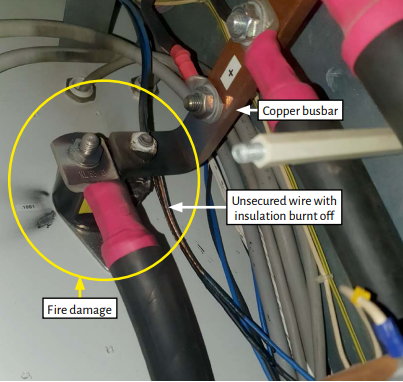As UK MAIB reports in its most recent Safety Digest, a tug was being prepared for the day’s operation when it lost all electrical power as the master pressed the main engine start button from the wheelhouse.
The incident
An engineer went to the engine room and reset the main 24V direct current (DC) circuit breaker and alarms to restore power. The engineer attempted to start the engine locally and the tug once again lost all electrical power. The engineer opened the 24V DC control panel and found that a small fre had ignited around one of the interior insulated brackets. The engineer isolated the panel and used a carbon dioxide fire extinguisher to put the fire out. The damage to the equipment was limited, but another tug needed to be mobilised to undertake the day’s planned work while repairs were carried out.
The cause of the fire was traced to an unsecured wire inside the 24V DC control panel, which was touching the copper busbar that supplied starting power to the main engine. Over time, vibration had caused the insulation surrounding the unsecured wire to wear through until the wire’s conductor made contact with the busbar. The powering up of the circuit caused a short-circuit and conducted a massive current. The circuit breaker protecting the system opened and
interrupted the circuit when the master pressed the start button, and this was repeated when the engineer reset it and tried to start the engine again. The unsecured wire was not designed to withstand such a high current even for a short time and rapidly heated up, burning away its remaining insulation and starting a small fire.
An inspection of the 24V DC control panel found several other unsecured wires, demonstrating that the risk remained for a similar event to happen again.
The tug owners arranged a check of all control cabinets and any identified loose wires were properly secured.

Credit: UK MAIB
Lessons learned
- Check → Circuit breakers and fuses generally trip for a reason. A quick check of equipment and wiring before resetting breakers can help avoid problems.
- Maintain → Electrical wiring is more than just a means to transfer power from A to B. Wires must be securely fastened to prevent them rubbing against anything that could damage the protective insulation covering the inner conductor. Make sure new wiring is routed correctly, secured to cable trays and clear of any hard edges.
- Action → During inspections of electrical panels engineers should be aware of the risk posed by poorly supported wiring and loose connections and take appropriate action to reduce it to a safe level: find it, isolate it, secure it.
- Risk → An electrical system does not require high voltage to be dangerous; this case demonstrates that a short-circuit in a 24V DC power supply is able to start a fire and serves as a cautionary tale for all vessel operators, commercial or otherwise.






























































